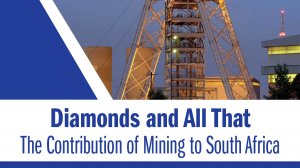- Diamonds and All That – The Contribution of Mining to South Africa0.41 MB
This year, 2017, is the 150th anniversary of the discovery of diamonds in South Africa. Actually, that is probably not strictly true, as diamonds might have been discovered earlier by people who never put them to commercial use. But the discovery of the fi rst diamond on the banks of the Orange River near Hopetown in 1867 sparked off the development of mining in the country. It also sparked off a great many other things, including the establishment of the fi rst stock exchange in Africa in nearby Kimberley in 1881. Other by-products of the discovery of diamonds were two universities, those of the Witwatersrand and Pretoria, which had their origins in a school of mines set up in Kimberley in 1896.
The man who consolidated thousands of small diggings in Kimberley to found De Beers Consolidated Mines was Cecil Rhodes, who then used the profi ts to extend into gold mining in and around Johannesburg.
Railways from the coast to the interior had to be built to serve the needs of mining. Factories to manufacture everything from steel to dynamite to boots had to be erected. The Rand Water Board was established in the early part of the century. And so on. Today South Africa is the 42nd largest economy in the world out of 190 in nominal GDP (and 32nd largest in purchasing power parity terms), thanks to the growth and industrialisation triggered by the commercial development of its mineral resources.
Vast quantities have been extracted. South African diamonds adorn the heads of British monarchs when they are crowned. South African coal keeps houses warm and industry turning both in this country and elsewhere. Cars around the world use South African platinum to reduce pollution. South African gold is to be found in the vaults of central banks and perhaps also under mattresses all over the world. The ground below the South African veld nevertheless still holds the world’s largest reserves of mineral resources if the even richer reserves of oil in other countries are not taken into account. Some years ago the value of our minerals was put at $2.5 trillion.
But our mining industry is in danger. Mining all over the world is subject to the extreme volatility of commodity prices. Governments in many countries seek to tax “windfall profi ts” made by mining companies. The South African industry, however, faces particular challenges arising in part from the particular history of its development under the apartheid system. These challenges are compounded by the government’s “empowerment” and other requirements in a “Mining Charter” introduced in 2004, and also by increasingly vocal environmental lobbyists. Following a violent strike and clashes in which 10 people were murdered and the lethal shooting of 34 miners at Lonmin’s platinum mine at Marikana near Rustenburg in August 2012, the wages and housing conditions of black miners were subjected to renewed critical scrutiny, both in South Africa and abroad.
The main focus of this paper will be the current contribution that mining makes, but it will start with a historical perspective and end with some remarks about the future.
Report by the Institute of Race Relations
EMAIL THIS ARTICLE SAVE THIS ARTICLE ARTICLE ENQUIRY
To subscribe email subscriptions@creamermedia.co.za or click here
To advertise email advertising@creamermedia.co.za or click here











